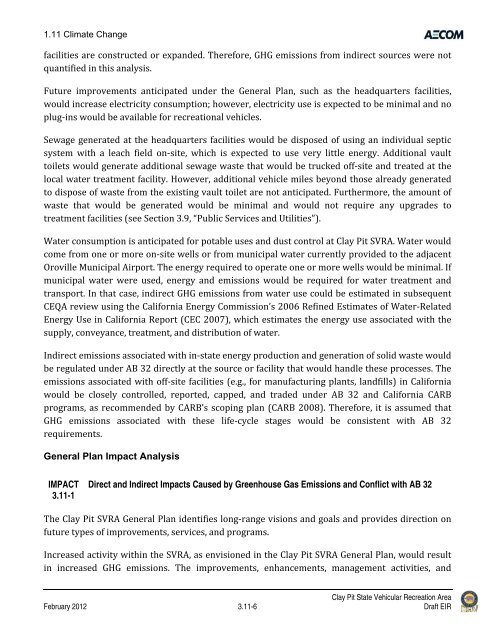Draft Environmental Impact Report - California Off Highway Vehicle ...
Draft Environmental Impact Report - California Off Highway Vehicle ...
Draft Environmental Impact Report - California Off Highway Vehicle ...
You also want an ePaper? Increase the reach of your titles
YUMPU automatically turns print PDFs into web optimized ePapers that Google loves.
1.11 Climate Change<br />
facilities are constructed or expanded. Therefore, GHG emissions from indirect sources were not<br />
quantified in this analysis.<br />
Future improvements anticipated under the General Plan, such as the headquarters facilities,<br />
would increase electricity consumption; however, electricity use is expected to be minimal and no<br />
plug‐ins would be available for recreational vehicles.<br />
Sewage generated at the headquarters facilities would be disposed of using an individual septic<br />
system with a leach field on‐site, which is expected to use very little energy. Additional vault<br />
toilets would generate additional sewage waste that would be trucked off‐site and treated at the<br />
local water treatment facility. However, additional vehicle miles beyond those already generated<br />
to dispose of waste from the existing vault toilet are not anticipated. Furthermore, the amount of<br />
waste that would be generated would be minimal and would not require any upgrades to<br />
treatment facilities (see Section 3.9, “Public Services and Utilities”).<br />
Water consumption is anticipated for potable uses and dust control at Clay Pit SVRA. Water would<br />
come from one or more on‐site wells or from municipal water currently provided to the adjacent<br />
Oroville Municipal Airport. The energy required to operate one or more wells would be minimal. If<br />
municipal water were used, energy and emissions would be required for water treatment and<br />
transport. In that case, indirect GHG emissions from water use could be estimated in subsequent<br />
CEQA review using the <strong>California</strong> Energy Commission’s 2006 Refined Estimates of Water‐Related<br />
Energy Use in <strong>California</strong> <strong>Report</strong> (CEC 2007), which estimates the energy use associated with the<br />
supply, conveyance, treatment, and distribution of water.<br />
Indirect emissions associated with in‐state energy production and generation of solid waste would<br />
be regulated under AB 32 directly at the source or facility that would handle these processes. The<br />
emissions associated with off‐site facilities (e.g., for manufacturing plants, landfills) in <strong>California</strong><br />
would be closely controlled, reported, capped, and traded under AB 32 and <strong>California</strong> CARB<br />
programs, as recommended by CARB’s scoping plan (CARB 2008). Therefore, it is assumed that<br />
GHG emissions associated with these life‐cycle stages would be consistent with AB 32<br />
requirements.<br />
General Plan <strong>Impact</strong> Analysis<br />
IMPACT<br />
3.11-1<br />
Direct and Indirect <strong>Impact</strong>s Caused by Greenhouse Gas Emissions and Conflict with AB 32<br />
The Clay Pit SVRA General Plan identifies long‐range visions and goals and provides direction on<br />
future types of improvements, services, and programs.<br />
Increased activity within the SVRA, as envisioned in the Clay Pit SVRA General Plan, would result<br />
in increased GHG emissions. The improvements, enhancements, management activities, and<br />
Clay Pit State Vehicular Recreation Area<br />
February 2012 3.11-6 <strong>Draft</strong> EIR








